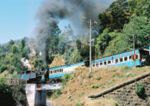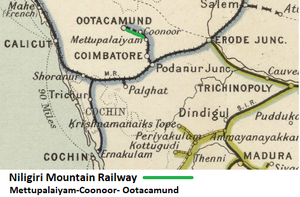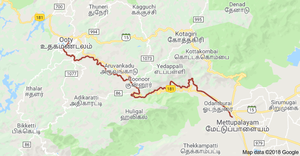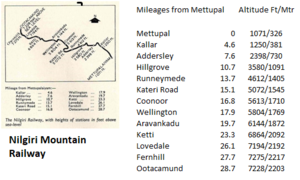Difference between revisions of "Nilgiri Mountain Railway"
HughWilding (talk | contribs) (Content & image added) |
('SIR System Metre Gauge' link added) |
||
| (20 intermediate revisions by 7 users not shown) | |||
| Line 1: | Line 1: | ||
{{Line Railways Infobox | {{Line Railways Infobox | ||
| − | |image= | + | |image= NMR up train at Kateri Road 05-02-28 04.jpg |
| − | |caption= | + | |caption= ''Class 'X' on up train at Kateri Road'' |
|route= [[Mettupalaiyam]] to [[Ootacamund]] | |route= [[Mettupalaiyam]] to [[Ootacamund]] | ||
|gauge1= Metre gauge | |gauge1= Metre gauge | ||
| Line 11: | Line 11: | ||
|gauge4= | |gauge4= | ||
|gauge4details= | |gauge4details= | ||
| − | |timeline1date= | + | |timeline1date= 1885 |
| − | |timeline1details= | + | |timeline1details= First company formed |
| − | |timeline2date= | + | |timeline2date= 1899 |
| − | |timeline2details= | + | |timeline2details= First section opened to traffic |
| − | |timeline3date= | + | |timeline3date= 1903 |
| − | |timeline3details= | + | |timeline3details= Line purchased by GoI |
| − | |timeline4date= | + | |timeline4date= 1908 |
| − | |timeline4details= | + | |timeline4details= Construction completed by PWD |
|timeline5date= | |timeline5date= | ||
|timeline5details= | |timeline5details= | ||
| Line 31: | Line 31: | ||
}} | }} | ||
| − | + | [[File: Nilgiri Mountain Railway Map.png|thumb|'''Nilgiri Mountain Railway''' - Location Map]] | |
| + | [[File: Nilgiri Mountain Railway Map line of route.png|thumb|'''Nilgiri Mountain Railway''' - Line of Route]] | ||
| + | [[File: Nilgiri Mountain Railway Map with mileages and altitudes.png|thumb|'''Nilgiri Mountain Railway''' - with mileages and altitudes]] | ||
| + | The '''Nilgiri Mountain Railway'''(NMR) is a metre gauge ([[Rail_gauge_#Metre_Gauge|MG]]) rack railway from [[Mettupalaiyam]] to [[Ootacamund|Ootacamund, often called Ooty]] a distance of 28.7 miles (46km), that is today a tourist attraction and a UNESCO World Heritage Site. The line climbs from 1071 feet(326 mtrs) above sea level to 7228 feet(2203 mtrs) over this length. Diesels can only haul NMR trains on the top section between [[Coonoor]] and [[Ootacamund |Ooty]]. | ||
| + | |||
| + | “The original Nilgri Railway Company was registered on the 30th September 1885 ... and a contract was executed with the Secretary of State on the 26th February 1886. The original Company went into liquidation in April 1894 and a new Company was formed in February 1896 to purchase the line from the former Company and supply the capital required to complete it and to construct the proposed extension to Ootacamund” | ||
| + | <ref>[https://archive.org/stream/BombayBarodaAndCentralIndiaRailwaySystem/Bombay_Baroda_And_Central_India_Railway_System#page/n149/mode/2up " Administration Report on the Railways in India – corrected up to 31st March 1918"; Superintendent of Government Printing, Calcutta; page 141]; Retrieved 10 Feb 2016</ref> | ||
| + | |||
| + | The metre gauge([[Rail_gauge_#Metre_Gauge|MG]]) line from [[Mettupalaiyam]] to [[Coonoor]], a length of 17 miles (27km), was completed by the new Company and opened for traffic on 15th June 1899. The railway was initially worked by the [[Madras Railway]](MR) Company under an agreement with the Government of India([[Government of India |GoI]]). | ||
| + | |||
| + | On the offer of the new Company to sell the line it was purchased by the Government for £235,000 on the 1st January 1903 and MR continued to work the line up to 31 December 1907. Thereafter the working was undertaken by [[South Indian Railway]](SIR) Company. | ||
| + | |||
| + | The MG extension to [[Ootacamund]], a further 12 miles(19km), was constructed by the Government and opened 1908 | ||
== History == | == History == | ||
| + | Following the opening of the [[Madras Railway]] broad gauge line from [[Madras]] to [[Calicut]] in 1862, a 26 mile, broad gauge branch from [[Podanur]] to [[Mettupalaiyam]], the '[[Mettupalaiyam Branch Line]]' was opened to traffic in 1873 and plans discussed to extend this into the [[Nilgiri Hills]] - the "Blue Mountains". | ||
| + | |||
| + | In 1885, the '''Nilgiri Railway Company''' was formed with construction beginning in 1891. Initially, it was intended to adopt the ''Rigi'' rack system but eventually the ''Abt'' rack system was chosen. [[Horace Bell]] continued to act in a private capacity as Consulting Engineer in London, he had in 1894 retired from his position in India as Consulting Engineer for the State [[Railway Board]]. | ||
| − | + | In 1896, a new company was formed with a guarantee (3% return during the construction period) from the Government of India([[Government of India |GoI]]) following the failure of the 1885 company. | |
| − | In | + | In 1899 the first section, from [[Mettupalaiyam]] to [[Coonoor]] (including 12 miles of rack), was opened to working by the [[Madras Railway]]. In 1903 the GoI purchased the line and contracted its working to the [[Madras Railway]]. |
| − | + | When the [[Madras Railway]] was merged into the [[Madras and Southern Mahratta Railway]] in 1907, the NMR contract was awarded to the [[South Indian Railway]](SIR). The railway was included as part of the [[South_Indian_Railway_-_Lines_Owned_and_Worked#SIR System Metre Gauge|'SIR System Metre Gauge']]. | |
| − | + | Construction of the extension from [[Coonoor]] to [[Ootacamund]] was completed by the GoI [[Public Works Department]] in 1908, [[Robert Richard Gales]] was the Engineer-in-Chief on the project <ref>[http://www.gracesguide.co.uk/1922_Who's_Who_In_Engineering:_Name_G Grace's Guide "Who's Who 1922 - Gales R R"]; Retrieved 18 Jul 2016</ref>. | |
In due course, the NMR became part of '''Southern Railway''', a zone of Indian Railways. | In due course, the NMR became part of '''Southern Railway''', a zone of Indian Railways. | ||
| + | == Gallery== | ||
| + | <gallery> | ||
| + | File:The Nilgiri Mountain Railway.jpg|<center> The Nilgiri Mountain Railway.jpg </center> | ||
| + | File:NMR at Coonoor.jpg| <center> At Coonoor station </center> | ||
| + | File:NMR looking back.jpg| <center>Looking back up the track </center> | ||
| + | File:NMR tunnel.jpg| <center>Through a tunnel </center> | ||
| + | File:NMR station at Ooty.jpg| <center>Ooty Station sign </center> | ||
| + | File:NMR at Ooty.jpg| <center>At Ooty Station </center> | ||
| + | </gallery> | ||
| + | |||
| + | ==External Sources== | ||
| + | * “Ascent to Ooty” by H C Hughes and P J Bawcutt, Railway Magazine November 1967 Vol 113 No 789 Transport and Technical Publications. This article has been transcribed by FIBIS. The map with the mileages and altitudes is from this article. | ||
| + | * [https://en.wikipedia.org/wiki/Nilgiri_Mountain_Railway Wikipedia “ Niligiri Mountain Railway”] | ||
== External links == | == External links == | ||
| + | *[http://en.wikipedia.org/wiki/The_Nilgiris_District "Nilgiris District"] ''Wikipedia''. | ||
| + | |||
| + | *[http://en.wikipedia.org/wiki/Nilgiri_Mountain_Railway "Nilgiri Mountain Railway"] ''Wikipedia''. | ||
| − | [http://www. | + | *[http://www.nilgiris.tn.gov.in/ "Heritage Site"] ''The Nilgiris - District of Blue Mountains''. |
| − | [http://en.wikipedia.org/wiki/ | + | *[http://en.wikipedia.org/wiki/Rack_railway "Rack railway"] ''Wikipedia''. |
| − | [http:// | + | *[http://www.youtube.com/watch?v=gD2LJ9fUeII Indian Hill Railways: The Nilgiri Mountain Railway] youtube.com One hour BBC documentary film. |
| − | [http://www. | + | *[http://www.bcmtouring.com/forum/travelogues-south-india-f63/one-day-trip-ooty-train-t15861/ A day trip on the Ooty train] Lovely series of photos from BCMTouring.com |
| + | *[http://www.indiaoutsidemywindow.com/2015/01/no-more-trains-to-hillgrove-station.html No more trains to Hillgrove station] 26 January 2015 "India outside my window" | ||
| − | + | {{#widget:Google PlusOne | |
| + | |size=medium | ||
| + | |count=true | ||
| + | }} | ||
| + | == References == | ||
| + | <references /> | ||
[[Category:Railways]] | [[Category:Railways]] | ||
| + | [[Category:Assisted Railways]] | ||
[[Category:State Railways]] | [[Category:State Railways]] | ||
| + | [[Category:Nilgiri Mountain Railway]] | ||
Latest revision as of 09:35, 6 October 2020
| Nilgiri Mountain Railway | ||
|---|---|---|
 Class 'X' on up train at Kateri Road | ||
| Line of route | ||
| Mettupalaiyam to Ootacamund | ||
| Gauge / mileage | ||
| Metre gauge | 17 miles (1905) 29 miles (1908) | |
| Timeline | ||
| 1885 | First company formed | |
| 1899 | First section opened to traffic | |
| 1903 | Line purchased by GoI | |
| 1908 | Construction completed by PWD | |
| Key locations | ||
| Presidency | Madras | |
| Stations | Mettupalaiyam, Coonoor, Ootacamund | |
| System agency | ||
| 1899-1907 | Madras Railway | |
| 1908 | South Indian Railway | |
| 1951 | Southern Railway (IR zone) | |
| How to interpret this infobox | ||
The Nilgiri Mountain Railway(NMR) is a metre gauge (MG) rack railway from Mettupalaiyam to Ootacamund, often called Ooty a distance of 28.7 miles (46km), that is today a tourist attraction and a UNESCO World Heritage Site. The line climbs from 1071 feet(326 mtrs) above sea level to 7228 feet(2203 mtrs) over this length. Diesels can only haul NMR trains on the top section between Coonoor and Ooty.
“The original Nilgri Railway Company was registered on the 30th September 1885 ... and a contract was executed with the Secretary of State on the 26th February 1886. The original Company went into liquidation in April 1894 and a new Company was formed in February 1896 to purchase the line from the former Company and supply the capital required to complete it and to construct the proposed extension to Ootacamund” [1]
The metre gauge(MG) line from Mettupalaiyam to Coonoor, a length of 17 miles (27km), was completed by the new Company and opened for traffic on 15th June 1899. The railway was initially worked by the Madras Railway(MR) Company under an agreement with the Government of India(GoI).
On the offer of the new Company to sell the line it was purchased by the Government for £235,000 on the 1st January 1903 and MR continued to work the line up to 31 December 1907. Thereafter the working was undertaken by South Indian Railway(SIR) Company.
The MG extension to Ootacamund, a further 12 miles(19km), was constructed by the Government and opened 1908
Contents
History
Following the opening of the Madras Railway broad gauge line from Madras to Calicut in 1862, a 26 mile, broad gauge branch from Podanur to Mettupalaiyam, the 'Mettupalaiyam Branch Line' was opened to traffic in 1873 and plans discussed to extend this into the Nilgiri Hills - the "Blue Mountains".
In 1885, the Nilgiri Railway Company was formed with construction beginning in 1891. Initially, it was intended to adopt the Rigi rack system but eventually the Abt rack system was chosen. Horace Bell continued to act in a private capacity as Consulting Engineer in London, he had in 1894 retired from his position in India as Consulting Engineer for the State Railway Board.
In 1896, a new company was formed with a guarantee (3% return during the construction period) from the Government of India(GoI) following the failure of the 1885 company.
In 1899 the first section, from Mettupalaiyam to Coonoor (including 12 miles of rack), was opened to working by the Madras Railway. In 1903 the GoI purchased the line and contracted its working to the Madras Railway.
When the Madras Railway was merged into the Madras and Southern Mahratta Railway in 1907, the NMR contract was awarded to the South Indian Railway(SIR). The railway was included as part of the 'SIR System Metre Gauge'.
Construction of the extension from Coonoor to Ootacamund was completed by the GoI Public Works Department in 1908, Robert Richard Gales was the Engineer-in-Chief on the project [2].
In due course, the NMR became part of Southern Railway, a zone of Indian Railways.
Gallery
External Sources
- “Ascent to Ooty” by H C Hughes and P J Bawcutt, Railway Magazine November 1967 Vol 113 No 789 Transport and Technical Publications. This article has been transcribed by FIBIS. The map with the mileages and altitudes is from this article.
- Wikipedia “ Niligiri Mountain Railway”
External links
- "Nilgiris District" Wikipedia.
- "Nilgiri Mountain Railway" Wikipedia.
- "Heritage Site" The Nilgiris - District of Blue Mountains.
- "Rack railway" Wikipedia.
- Indian Hill Railways: The Nilgiri Mountain Railway youtube.com One hour BBC documentary film.
- A day trip on the Ooty train Lovely series of photos from BCMTouring.com
- No more trains to Hillgrove station 26 January 2015 "India outside my window"
References
- ↑ " Administration Report on the Railways in India – corrected up to 31st March 1918"; Superintendent of Government Printing, Calcutta; page 141; Retrieved 10 Feb 2016
- ↑ Grace's Guide "Who's Who 1922 - Gales R R"; Retrieved 18 Jul 2016


